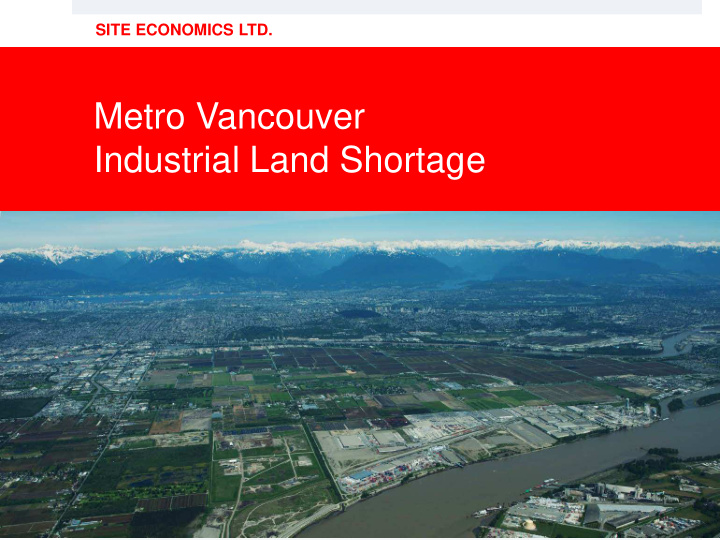



SITE ECONOMICS LTD. Metro Vancouver Industrial Land Shortage 1
The Issue - Metro Vancouver Indicates Vacant Industrial Land Absorbed by 2026 2
Consequences of the Land Shortage Makes PMV less competitive Reduces the wide range of needed services if the gateway does not grow and evolve Loss of future economies of scale that benefits large concentrations of similar businesses Loss of new public infrastructure a larger Gateway would require 3
Consequences of Industrial Land Shortage on Metro Vancouver Region Less efficient goods movement with more international containers on rail and truck longer and less use of more suitable domestic containers Increased energy use with attendant environmental impacts Very high real estate prices and operating costs which harm existing business Massive loss of jobs, in a region with a persistently weak economy and relatively small office employment component 4
Land Demand Increasing Annual land demand for logistics space will increase from 100 acres currently to 160 acres (status quo) or 213 acres per year (T2), due to the doubling of container throughput PMV, with T2 will require at least 2,500 acres of vacant industrial land by 2035, even with dramatically improved efficiency Metro Vancouver’s non port industrial land demand, has historically been 150 acres annually and it will require at least 3,000 acres by 2035 5
Solutions – Optimize Existing Industrial Making better use of the existing land base is important and ongoing but it is already largely optimized Industrial densification and assembly is very difficult and prohibitively expensive Optimizing all forms of industrial land use, even to the maximum possible is insufficient to satisfy even one year of new demand, and it is already being done 6
Solutions Inland Terminal Calgary Estimate 50 acres of PMV related logistics developments relocate to Calgary and this will soon double to 100 acres per year, due to the local land shortage Metro Vancouver is expected to lose approximately 2,000 acres of industrial development to Calgary by 2035, as this inland terminal takes an ever larger share of growth Calgary is an inland terminal and regional logistics hub but it is not as efficient as Metro Vancouver, where more international containers should be consolidated into domestic containers. 7
Every New 100 Acres Developed Is worth $1.7 Billion Per Year Ongoing Annual Property Taxes/Levies Annual Property Taxes to Local Municipality $ 3,083,395 Annual Property Taxes to Region & Other Taxing Authorities $ 4,625,093 Total Property Taxes / Levies $ 7,708,488 Discount Rate 10.0% NPV of Perpetual Revenue Stream $ 77,084,882 Ongoing Employment of Complete Project Jobs Salaries $ 112,123,440 Discount Rate 10.0% NPV of Perpetual Revenue Stream $ 1,121,234,400 NPV of Direct Economic Effects $ 1,198,319,282 Total Initial Development/Servicing/Construction Costs $ 163,564,058 Total Initial Costs and NPV of Direct Economic Effects $ 1,361,883,340 Economic Multiplier / NPV Secondary Economic Effects 1.30 $ 408,565,002 NPV of all Direct and Secondary Economic Effects $ 1,770,448,342 8
Land Supply Decreasing Metro Vancouver estimates 5,600 acres on industrial land are vacant but only 4,000 acres can be readied for development National Association of Industrial and Office Properties, and the private sector, estimates supply is less than 2,500 acres Only 1,000 acres of land is suitable for logistics given the need for large, well-located sites with highway access and flat topography 9
Developed and Vacant SITE ECONOMICS LTD. 3/9/2016 Industrial Land 2015 10
Vacant Potential Logistics Lands SITE ECONOMICS LTD. 3/9/2016 11
Industrial Lands Richmond/ Delta 25,000 20,000 15,000 Vacant Industrial (ac) Developed Industrial (ac) 10,000 5,000 Red is Vacant Land for Logistics 0 Delta Richmond Surrey Other Total 12
Where Future Industrial Should Locate 13
Conclusions Metro Vancouver will clearly run out of industrial land within the next 15 to 20 years It will run out of logistics oriented and required lands in less than 10 years Without land on which to grow and evolve the supply chain the international gateway will become less competitive and the regional economy will be negatively impacted To secure international gateway logistics oriented lands should be preserved and enhanced 17
Site Economics Ltd. – Richard Wozny Real estate development consulting services to hundreds of major clients. Over 1,000 real estate development studies of projects worth over $100 billion. Many of the key technical studies on SSS, Inland Terminals, Logistics planning and best building practices, impact assessments. Numerous industrial real estate developments and consultant of record on the vacant industrial land base. 18
Recommend
More recommend